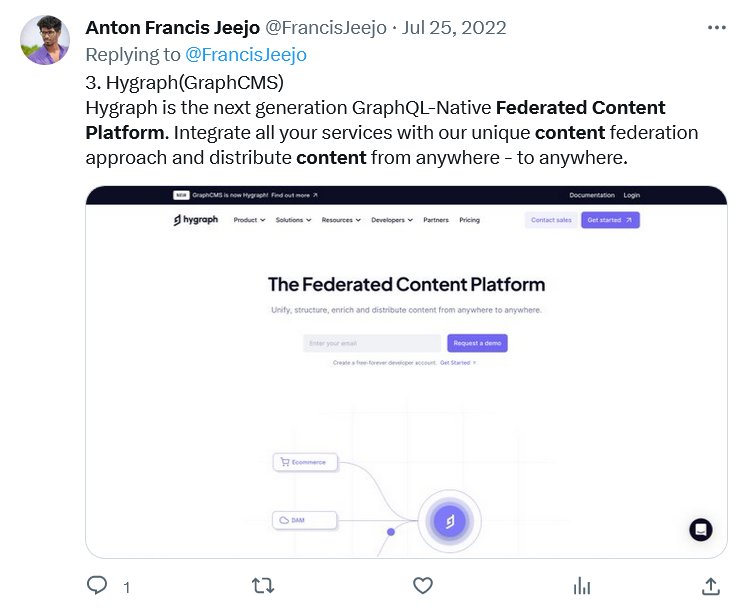Federated platforms – the next big thing in content management?

• Content management is evolving rapidly.
• What lies beyond the headless content management system?
• Federated content platforms can deliver content as needed in a new and seamless way.
It is fundamental to the nature of modern humanity that we love and use things which “just work,” significantly more than we enjoy the struggle to figure out how to do simple things in complicated ways.
But the nature of things that “just work” changes over time, and we adapt to new norms. In home entertainment, for instance, the idea of having to leave the house, go to the store, buy a disc, come home, and put it into a specialized machine all for the privilege of having a new release movie to watch seems like a lot of effort to the streaming generation, but it was once the height of convenience to the movie theater generation – you could have a movie at home, in your pajamas, to pause, rewind, rewatch, etc. It just worked then, but increasingly, as technology has evolved, it doesn’t just work anymore.
The same is true of content moderation when it comes to building what the internet will look like, now and in its next iteration.
The evolution of content management systems.
For two decades or more, the traditional content management system (CMS) was effective – allowing you to handle both a website’s content and its front end through a single, relatively easy-to-learn back-end (the WordPresses and Drupals of the world). WordPress itself still underpins more than 40% of all websites on the planet, so you could argue that the traditional content management system is alive and well.
But the rise of its successor, the so-called “headless” CMS, is already well underway. Headless content management systems deal strictly with the content you’re uploading, and then place it on display wherever and whenever you want it, via an API. That gives you significantly more flexibility in how you display – and how your audience experiences – your content.
And what happens next? Businesses everywhere are looking to be on the crest of the wave of evolution and development, and many are already looking ahead of the headless content management system. Especially given the development of generative AI and the shift in how people view content, the nature of what “just works” is already in flux.
If we wanted to fill your world with speculative science fiction, we could spin you a hundred realities for what happens after the headless CMS.
Instead, we sat down with Michael Lukaszcyk, CEO of Hygraph, a company already delivering what it calls federated content platforms as a way of future-proofing company content and, according to Michael, getting past an “innovation bottleneck” that’s formed around pre-existing web architecture.
The future of content management?
THQ:
Forgive the slightly mangled explanation of what you do. What are federated content platforms, and why would any company need one?
ML:
Federated content platforms are an evolution of the headless CMS.
It’s always important to think about innovation and differentiation and how to position yourself against the competition, in particular in a fierce market like content management.
So we’ve always been looking for what could be the next evolution of the headless content management system. We think the federated content platform is that evolution.
What a federated content platform allows you to do is not just bring your content onto any channel – any website, any phone app, any smart TV app whatsoever – it allows you to integrate any content and data that lives within other systems.
So third-party systems via a universal content API, that helps you improve the developer experience when you build any sort of application that consists of multiple data sources, to get the data easily out and into the applications that you want.
THQ:
You talk about federated content platforms as addressing an innovation bottleneck in traditional and headless content management systems. Just so we’re on the same page – what’s an innovation bottleneck, and where do you think there is one?
The innovation bottleneck in headless content management.
ML:
Innovation bottlenecks can take many forms. For example, you have an innovation bottleneck if you don’t have an engineering capacity in your company. But we’re talking about innovation bottlenecks in the context of composable architectures, which is a new reality to which a lot of enterprise stacks are waking up.
With composable architecture – simply, your back-end that consists of different modules that you buy or build together – you pick your favorite CMS, your favorite PIM (product information management tool), your favorite digital asset management system, and maybe there’s some sort of homegrown API or database in the mix.

An innovation bottleneck can stop you solving genuine problems.
We often refer to the innovation bottleneck as happening in the piece that brings those systems together. Very often, we have seen companies building custom middleware solutions, which are a centralized, self-built software components that know how to pull the data out of the different systems, and expose the data again in a unified manner.
It joins stuff together. And it’s this middleware component that becomes a bottleneck, because 1) it’s very hard to build, and 2) it’s a necessary evil in best of breed stacks, because you have to make sure if you have a modular modular stack, that everything is placed well together, and it’s well integrated.
This middleware component is very expensive to build, and it’s also very difficult to build – it takes serious know-how from engineers, architects, product leaders, and then you have to design it, you have to build it, you have to maintain it, you have to secure it, you have to scale it and wire it up.
That’s not necessarily contributing to the product that you’re building in the first place. It’s not adding customer value, it’s a necessary evil, and that’s an innovation bottleneck that companies shouldn’t have to deal with in a modular stack.
THQ:
So essentially, a middleware component is necessary, but it’s expensive, it’s difficult, and it’s rotting from the day you put it in? Alrighty.
The type of content, and how you manage it.
ML:
Exactly. And the more traditional CMS, from the first generation of content management systems, give you a website. The headless CMS, the second generation of CMS, will give you an API. That takes you a long way forward already. But if you’re still stuck in the first monolithic CMS world, you’re not even able to build the sort of modern experiences that people increasingly want and expect as “normal,” because you don’t even have an API to integrate into your stack.

Federated content platforms are a specialized development.
THQ:
What sort of experiences are we talking about? Are we talking about things that are known to the general, consuming public right now, or things that are coming, and that will be the next big thing?
ML:
We’re talking about use cases that we call “content-rich applications.” The market for solutions for building websites is very well explored.
What we’re building is a content engine for more interesting use cases around products, rather than websites that would market a certain product.
We’re looking at digital products, rather than just marketing websites around a digital product. Things like Netflix, or Peloton. The core of the product is content. And this content also needs to be maintained. Federated content platforms are almost like database systems for content-rich applications.

Netflix and content?
They still comes with the benefits of the CMS, because you need the interface to maintain and create the content and all the processes.
The difference between traditional and headless CMS.
The thing is, traditional content management systems won’t let you build something like a Netflix platform – the kind of thing more and more companies want to deliver, because more and more people want and expect to consume their content that way.
But a federated content platform will.

Michael Lukaszcyk, CEO of Hygraph.
In Part 2 of this article, we’ll dive deeper into the nuts and bolts of federated content platforms, and discover why they really might be something to take seriously.










